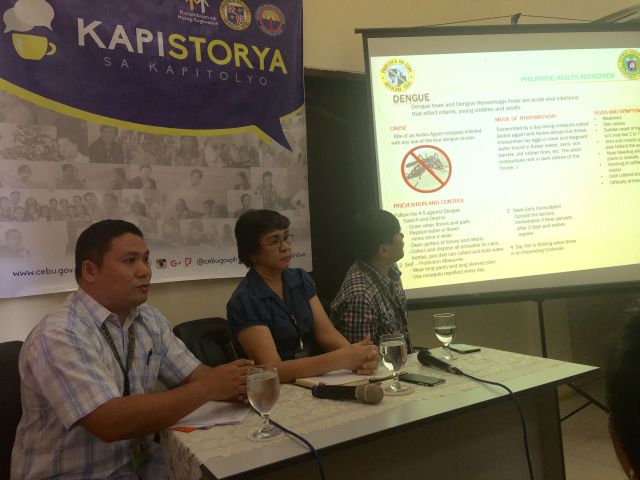
Dr. Egos (left), with Public Information Officer Ethel Natera and Salgado during yesterday’s Kapistorya. (CDN PHOTO/JOSE SANTINO S. BUNACHITA)
With the rainy season already here and a La Niña phenomenon expected later in the year, the Cebu Provincial Health Office (PHO) is advising the public to take precautionary measures against common diseases like dengue and diarrhea.
During yesterday’s Kapistorya, PHO officials revealed that from January to May this year alone, they have already recorded 1,326 dengue cases and five deaths.
“It’s usually the kids who are affected with dengue, from a couple of months old to pre-school or school age. This is because they are more vulnerable and their immune system is not yet mature,” said Wilfredo Salgado, PHO health education and promotions officer.
Most of the cases came from bigger towns in the province, he added.
Based on PHO records, the top three municipalities with the most number of dengue cases from January to May this year were Toledo City with 222 cases and one death, Balamban 192 cases and one death and Liloan 162 cases and two deaths. The fifth recorded death was in Talisay City, which registered 152 dengue cases.
Dr. Wilson Anthony Egos, PHO communicable diseases medicine coordinator, said that although dengue is endemic in the Philippines, more cases are usually recorded during the rainy season since pools of water tend to be left behind after rains and these are where dengue-carrying mosquitoes lay their eggs.
He advised the public to conduct their own search and destroy operations to eliminate dengue-carrying mosquitoes aside from those conducted by the PHO and municipal health officers. He also urged the public to cover water drums and pails and wear protective clothes.
If fever persists for more than two days, Egos said it’s important to already consult a doctor to avoid complications.
Based on PHO records, there have been a total of 2,461 recorded cases of dengue for the entire 2015.
The top three local government units (LGUs) with the most number of cases last year were Balamban, Carcar City and Daanbantayan.
Egos said the PHO, together with the Department of Health (DOH), will soon be conducting a mass dengue vaccination in some areas in the province.
“We’ve been meeting with the DOH. Soon, there’s going to be a mass immunization for the children. This will be a school-based immunization,” Egos said.
Although there’s still no scheduled date yet, Egos said the vaccination, which will be against the four different dengue strains, will be done within the year.
Aside from dengue, he said diarrhea is also common during the rainy season.
He advised people, especially those living in mountainous area where access to potable water is hard, to make sure that their water is not contaminated.
If not sure of the water’s source, he said it’s best to boil the water for at least 12 minutes.
During heavy rains, he said contaminated floodwater could reach spring boxes which are located near river banks and where people usually get their potable water. Even if these are usually enclosed, contamination could still occur.
The Provincial Board (PB) has already passed a resolution asking all 51 towns and cities in the province to use their quick response fund to prepare for La Niña.
The province currently has around P34 million in its quick response fund which is 30 percent of the total disaster funds of the province.
The PB also asked the local governments to start rehabilitating their drainage systems, creeks, rivers and water catchments.
“This august body believes in the importance of preparing the public for La Niña in order to mitigate, if not eliminate, the adverse effects of the said phenomenon,” read the resolution authored by Board Member Miguel Antonio Magpale approved by the PB last Monday.
Magpale said LGUs should not wait for the La Niña to hit the province. As early as now, they must initiate and implement plans to mitigate its effects, he said.
Disclaimer: The comments uploaded on this site do not necessarily represent or reflect the views of management and owner of Cebudailynews. We reserve the right to exclude comments that we deem to be inconsistent with our editorial standards.
